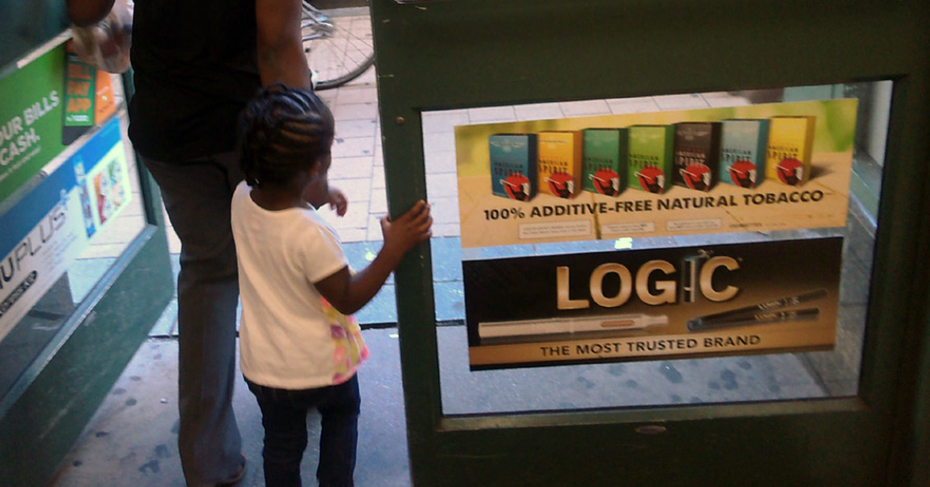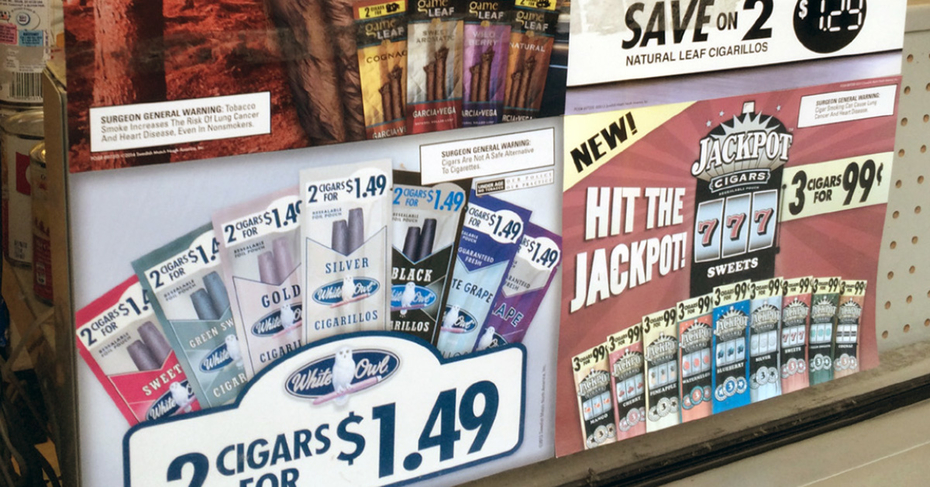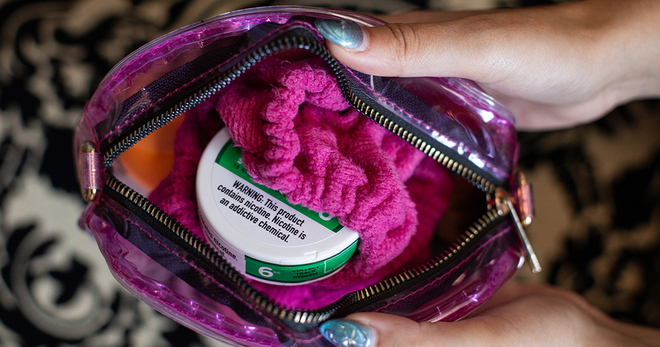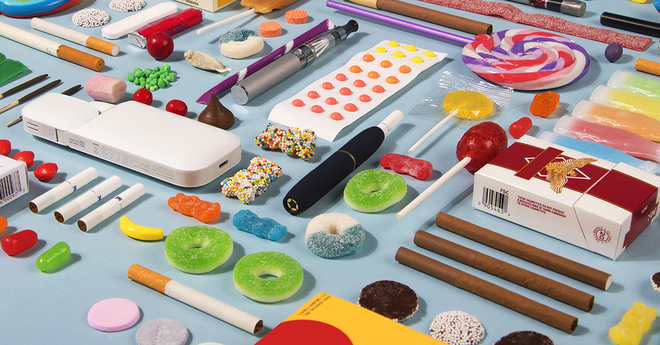
Colorful and close to candy: Surveying how the tobacco industry markets flavored products in stores
It’s clear that flavored tobacco products are especially appealing to young people. More than 80% of youth who have used tobacco report that they began with a flavored product and 97% of youth who vape use flavors. The skyrocketing youth use of e-cigarettes to epidemic levels has called further attention to the flavored products driving the crisis, especially JUUL.
Retail-based marketing — from placing e-cigarettes next to toys and candy near the checkout counter, to discounting prices on flavored tobacco products and displaying product ads in stores — can encourage young customers to try these flavored products.
A survey of tobacco retailers in two major cities highlights how the tobacco industry uses an array of in-store marketing to make its products, especially flavored tobacco products like menthol cigarettes and flavored varieties of e-cigarettes, smokeless tobacco and cigarillos, enticing to youth. Truth Initiative® partnered with Counter Tools, an organization that specializes in helping state and local partners build healthier communities, on a pilot study using store assessment questions that focused on the sale of flavored tobacco products. Researchers examined marketing in stores in Dayton and Cleveland, Ohio, two cities in “Tobacco Nation.” These cities are a part of a swath of the South and Midwest where a greater percentage of people smoke and policies limiting tobacco are less common.
Teams of trained community members looked at nearly 200 randomly selected retailers, including convenience stores, grocery stores, mass merchandisers, tobacco shops and drug stores. Convenience stores, popular among young people, were the most common type of tobacco retailer in both cities, where 100% of those surveyed sold tobacco products. Menthol cigarettes were available in nearly all stores in both cities and smokeless tobacco, especially popular in the Midwest, was available at two-thirds of stores in Dayton and about a quarter of stores in Cleveland. Nearly half the stores in Dayton and a quarter in Cleveland sold e-cigarettes and the majority of those stores also specifically sold pod-mod products such as JUUL.
The pilot study revealed that tobacco products were cheaper in neighborhoods with higher percentages of young people and that nearly every store located near a school displayed ads for flavored tobacco products outside. These findings, among others noted by researchers, demonstrate the need for local tobacco control policies that restrict flavors, especially in areas with high tobacco use rates and where fewer restrictive policies are in place.

Nearly every store located near a school displayed ads for flavored tobacco products outside.
PRICED TO SELL
Price discounts, coupons and in-store promotions and ads dominate the tobacco marketing landscape, which relies heavily on retailer-based publicity. Of the $9 billion that the largest U.S. tobacco product manufacturers spent on advertising in 2014, more than 95% went into so-called “point-of-sale” promotions. The strategy gets results: sales of tobacco products increase by 30% when discounts and promotions are advertised in stores.
The tobacco industry offers price cuts in several ways, from wholesale price drops to couponing and multipack discounts. Recently manufacturers have begun sending coupons to customers through their phones.
Youth are a particularly price-sensitive group. Those who are frequently exposed to retail-based tobacco marketing are twice as likely to try smoking as those who are exposed less often. About one-third of teenage experimentation with smoking can be directly attributed to tobacco marketing in stores.
In the two cities studied, price promotions were common. For instance, 94% of Dayton stores sold cigarillos, little cigars or blunts. Nearly 70% of those stores sold singles, with 87% of them advertising the little cigars for less than $1, an accessible price point for cash-strapped youth. Roughly 85% of Cleveland retailers sold cigarillos, little cigars or blunts, with nearly 89% selling singles. About 82% of those stores advertised the singles for less than $1.
Researchers also compared the pricing of cigarettes in neighborhoods that had higher percentages of households with children aged 5-17 (20.7% in Dayton and 21.1% in Cleveland) to those with lower percentages of households with children (13.1% in Dayton and 10.9% in Cleveland). They found that the lowest prices were in areas with higher concentrations of youth.
The findings in Cleveland and Dayton are similar to those from a study of Minnesota communities in 2009 when researchers discovered that stores in neighborhoods with larger numbers of youth were more likely to have lower-priced cigarettes. The study’s authors said the results suggest that at least some cigarette brands may be priced to appeal to youth.
Sales of tobacco products increase by 30% when discounts and promotions are advertised in stores.
LOCATION IS EVERYTHING
Retail-based marketing starts outside of stores, where colorful ads for tobacco products beckon to passersby. Flavored tobacco products were extremely likely to be marketed through exterior store ads, according to this study. Of the Dayton stores with outdoor ads, 97% had ads for flavored tobacco products. In Cleveland, 92% of stores with exterior ads publicized flavored products.
The survey also looked at marketing specifically at retailers near schools. Of the surveyed stores located within 1,000 feet of a school, nearly every retailer displayed exterior ads for flavored tobacco: 93% of Dayton stores and 100% of those surveyed in Cleveland.
Once inside a store, customers often face a bombardment of advertising. Tobacco companies pay retailers to place their flavored products in highly visible locations around checkout counters where customers are inclined to make impulse purchases, and in other easy-to-see spaces in retail environments.
Unlike traditional cigarettes and smokeless tobacco that are required by federal law to be kept behind the store counter, other flavored tobacco products, like cigars, cigarillos, and e-cigarettes — which also happen to be the most highly flavored products — can be displayed within easy reach of young people without requiring clerk assistance. Some retailers even place flavored tobacco products next to gum, candy and toys.
Roughly half of the retailers in Dayton displayed flavored tobacco products within one foot of candy, ice cream, soda or toys, according to the assessment. But in Cleveland, where an ordinance requiring customers to be 21 to purchase tobacco products took effect in 2016, less than 3% of stores had the products on display within a foot of candy, ice cream, soda or toys.
In July 2019, the state of Ohio followed Cleveland’s lead and raised the legal age to buy tobacco products to 21, bringing to 18 the number of states that bar sales of tobacco products to those under 21. Truth Initiative supports raising the age of sale for all tobacco products to 21.
The study also examined the placement of tobacco ads within stores. In Dayton, 54% of retailers placed the ads within 3 feet of the floor — or at young people’s eye level. But in Cleveland, only about 16% of stores placed them at eye level.

Tobacco companies pay retailers to place their flavored products in highly visible locations.
THE VALUE OF STORE ASSESSMENTS
The data collected during retail assessments are essential to understanding how tobacco products are marketed, but the actual gathering of the information may be even more valuable. When community members conduct the assessments, they see first-hand the extent and manner of tobacco marketing — from price reductions to placement of flavored tobacco products at eye level.
Community residents who collected the information in the two cities in Ohio were “inspired to take action by what they saw in stores and now see the retail environment with different eyes,” the study authors wrote. The assessments “can also serve as a tool for raising awareness of problems at the point of sale amongst data collectors, who can in turn become advocates for change and raise awareness throughout their communities.”
In fact, a 2015 study of counties nationwide showed that those that had conducted retail tobacco assessments were more than six times as likely to have adopted point-of-sale policies than those that had not. Spurred by concerns about tobacco marketing’s influence on youth, some communities around the nation have enacted store restrictions. These range from limiting price reductions and the amount of advertising on display to restricting where flavored tobacco products are placed on shelves and raising the age to buy tobacco products.
Retail assessments provide a powerful data-based tool to raise awareness, build community support for change and drive policy solutions to reduce tobacco use.
More in emerging tobacco products
Want support quitting? Join EX Program
By clicking JOIN, you agree to the Terms, Text Message Terms and Privacy Policy.
Msg&Data rates may apply; msgs are automated.


